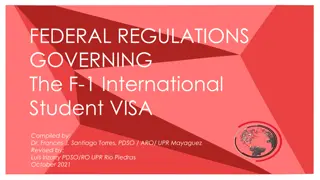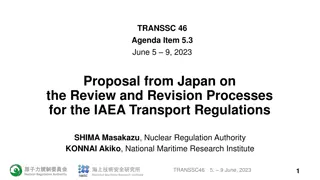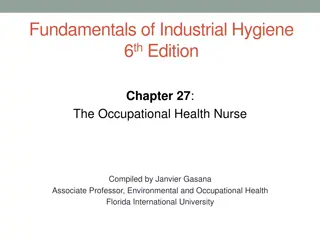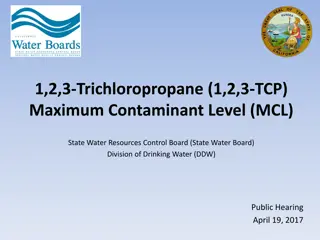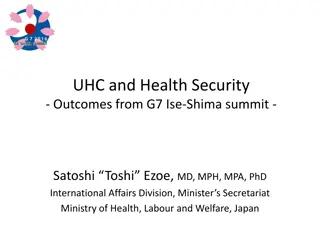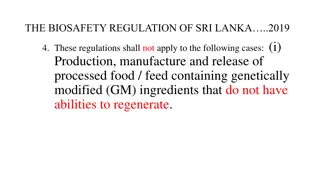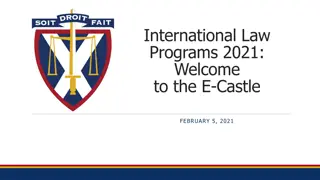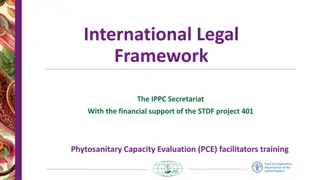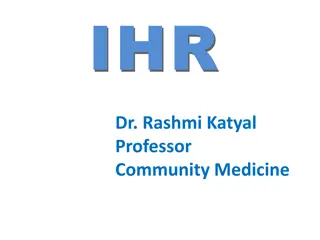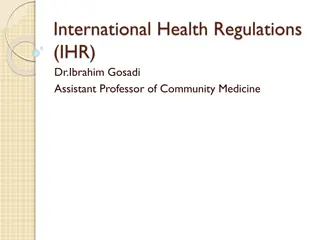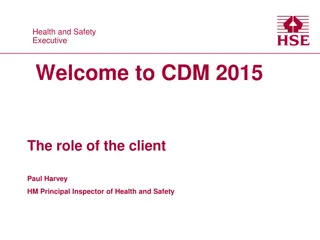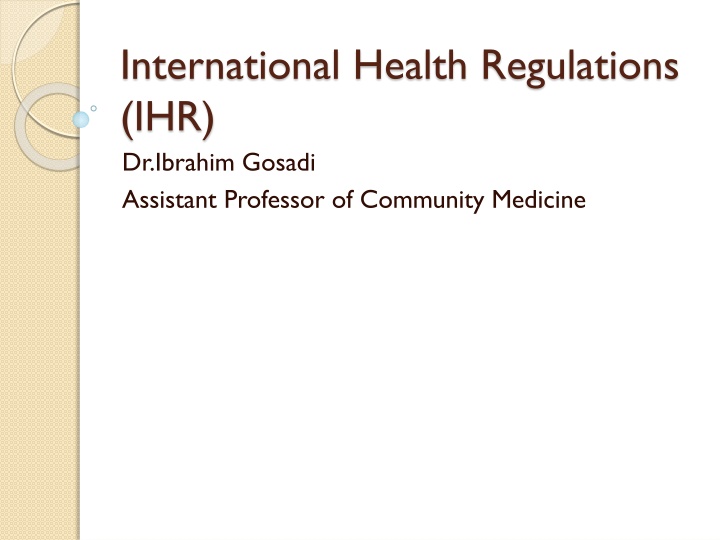
International Health Regulations (IHR) and Their Global Significance
Learn about the International Health Regulations (IHR) and their critical role in global public health security. Explore the purpose, scope, and importance of IHR in preventing, detecting, and responding to international disease threats. Discover how IHR has evolved to address various public health emergencies and facilitate international collaboration.
Download Presentation

Please find below an Image/Link to download the presentation.
The content on the website is provided AS IS for your information and personal use only. It may not be sold, licensed, or shared on other websites without obtaining consent from the author. If you encounter any issues during the download, it is possible that the publisher has removed the file from their server.
You are allowed to download the files provided on this website for personal or commercial use, subject to the condition that they are used lawfully. All files are the property of their respective owners.
The content on the website is provided AS IS for your information and personal use only. It may not be sold, licensed, or shared on other websites without obtaining consent from the author.
E N D
Presentation Transcript
International Health Regulations (IHR) Dr.Ibrahim Gosadi Assistant Professor of Community Medicine
Why have IHR? Serious and unusual disease events are inevitable Globalisation - problem in one location is everybody s headache
What is IHR? This legally-binding agreement. significantly contributes to global public health security. providing a new framework for the coordination of the management of events that may constitute a public health emergency of international concern. improve the capacity of all countries to detect, assess, notify and respond to public health threats.
Purpose and scope To prevent, protect against, control and provide a public health response to the international spread of diseases Restricted to public health risks, and which avoid unnecessary interference with international traffic and trade.
Whats new? From three diseases to all public health threats From preset measures to adapted response From control of borders to, also, containment at source
All public health threats IHR recognize that international disease threats have increased Scope has been expanded from cholera, plague and yellow fever to all public health emergencies of international concern They include those caused by infectious diseases, chemical agents, radioactive materials and contaminated food
What do the IHR call for? Strengthened national capacity for surveillance and control, including in travel and transport Prevention, alert and response to international public health emergencies Global partnership and international collaboration Rights, obligations and procedures, and progress monitoring
Acute public health threats are collectively managed The IHR define a risk management process where States Parties work together, coordinated by WHO, to collectively manage acute public health risks. The key functions of this global system, for States and WHO, are to: detect verify assess inform assist
Containment at source Rapid response at the source is: the most effective way to secure maximum protection against international spread of diseases key to limiting unnecessary health-based restrictions on trade and travel
Importance of national capacity The best way to prevent international spread of diseases is to detect public health events early and implement effective response actions when the problem is small Early detection of unusual disease events by effective national surveillance (both disease and event based) Systems to ensure response (investigation, control measures) at all levels (local, regional, and national) Routine measures and emergency response at ports, airports and ground crossings.
Core capacity requirements for designated points of entry PoE DESIGNATION OF POINTS OF ENTRY States Parties shall designate Airports and Ports for developing capacities . States Parties where justified for PH reasons, may designate ground crossings for developing capacities Annex 1b, taking into consideration volume and frequency of international traffic and public health risks of the areas in which international traffic originates. States Parties sharing common borders should consider: Bilateral and multilateral agreements Joint designation of adjacent ground crossing for capacities
Capacity Strengthening at Points of Entry PoE Core capacity requirements at all times (routine) (b) Equipment & personnel for transport ill travellers (a) Assessment and Medical care, staff & equipment (c) Trained personnel for inspection of conveyances (e) Trained staff and programme for vector control (d) ensure save environment: water, food, waste, wash rooms & other potential risk areas - inspection programmes
PoE Capacity requirements for responding to potential PHEIC (emergency) Provide assessment & care for affected travellers, animals: arrangements with medical, veterinary facilities for isolation, treatment & other services Provide space, separate from other travellers to interview suspect or affected persons b c Public Health Emergency Contingency plan: coordinator, contact points for relevant PoE, PH & other agencies a Provide for assessment, quarantine of suspect or affected travellers d Provide access to required equipment, personnel with protection gear for transfer of travellers with infection/ contamination To apply recommended measures, disinsect, disinfect, decontaminate, baggage, cargo, containers, conveyances, goods, postal parcels etc g e To apply entry/exit control for departing & arriving passengers f
Some principle approaches Continuous risks Continuous risks Routine measures in place "sanitary conditions" at points of entry and conveyances travellers, goods etc. Specific measures for certain known risks in place Vector control, vaccination Standing recommendations Sudden increase in risk Sudden increase in risk Detection information & verification notification risk assessment Response Support to investigation and control Information and recommendations
What does WHO do under the IHR? Designate WHO IHR contact points Support States Parties in assessing their public health risks, through the notification, consultation, and verification processes Inform State Parties of relevant international public health risks Recommend public health measures Assist States Parties in their efforts to investigate outbreaks and meet the IHR national core capacities requirements for surveillance and response and points of entry
WHO system of Global Outbreak Alert and Response Network GOARN Operations Event Intelligence Official, State sources Verification Risk Assessment WHO HQ, Regional & Country Offices, Collaborators and experts Response Global Outbreak Alert and Response Network
Countries challenges for IHR implementation Mobilize resources and develop national action plans Strengthen national capacities in alert and response Strengthen capacity at ports, airports, and ground crossings Maintaining strong threat-specific readiness for known diseases/risks Rapidly notify WHO of acute public health risks Sustain international and intersectoral collaboration Monitor progress of IHR implementation
IHR in Saudi Arabia: Case Study During Hajj Season of 2014, the country was subjected to the risk of Ebola Virus Disease outbreak during the Hajj season. What was the action plan conducted under the IHR?
IHR in Saudi Arabia: Case Study Firstly: the disease was announced to be endemic in west African countries: Guinea, Liberia and Sierra Leone in West Africa. Additionally, a localised spread of the virus was announced in certain areas of Nigeria
IHR in Saudi Arabia: Case Study This announcement indicated a Public Health Event of International Concern (PHEIC). Saudi Arabia, as a member state was informed about this PHEIC through the National IHR Focal Point. The National IHR Focal Point in Saudi Arabia was a representative of the Saudi Ministry of Health.
How does The National IHR Focal Point in Saudi Arabia receive information from the WHO? Through the WHO IHR Contact Points. (EMRO IHR contact point.)
Circle of Communication Information Shared PHEIC 1. WHO IHR Contact Point 4. National IHR Focal Point 3. Relevant National Authorities 2. National IHR Focal Point Implementation of action plans Information Shared
IHR in Saudi Arabia: Case Study A) The Information components: 1. surveillance, notification, consultation, verification, and information sharing at the endemic countries with EVD. 2. Announcement of the PHEIC with state parties. 3. Sharing of relevant public health knowledge about EVD with state parties.
IHR in Saudi Arabia: Case Study B) Action plan at endemic countries: 1. application of prevention and control measures in endemic countries. 2. Application of exit screening measures at Points of Entry. 3. information sharing with state parties.
IHR in Saudi Arabia: Case Study C) Action plan at Saudi Arabia: 1. Restriction of entry of citizens of affected countries. 2. Application of entry screening measures. 3. information sharing with relevant local authorities.
IHR in Saudi Arabia: Case Study C) Action plan at Saudi Arabia: 4. Assessment of the established capacity: Transportation system adherence to the IHR guidelines. Maintenance of core capacities at designated Points of Entry in Saudi Arabia: Jeddah airport, Madenah Airport, and Islamic seaport. In Jeddah.
IHR in Saudi Arabia: Case Study C) Action plan at Saudi Arabia: 5. Development of Public health Emergency Contingency Plans at Points of Entry. 6. Plan trials, monitoring and evaluation.
References http://www.who.int/ihr/en/ http://www.moh.gov.sa/en/Hajj/News/Page s/News-2014-09-24-001.aspx http://www.who.int/ihr/publications/97892 41596664/en/



